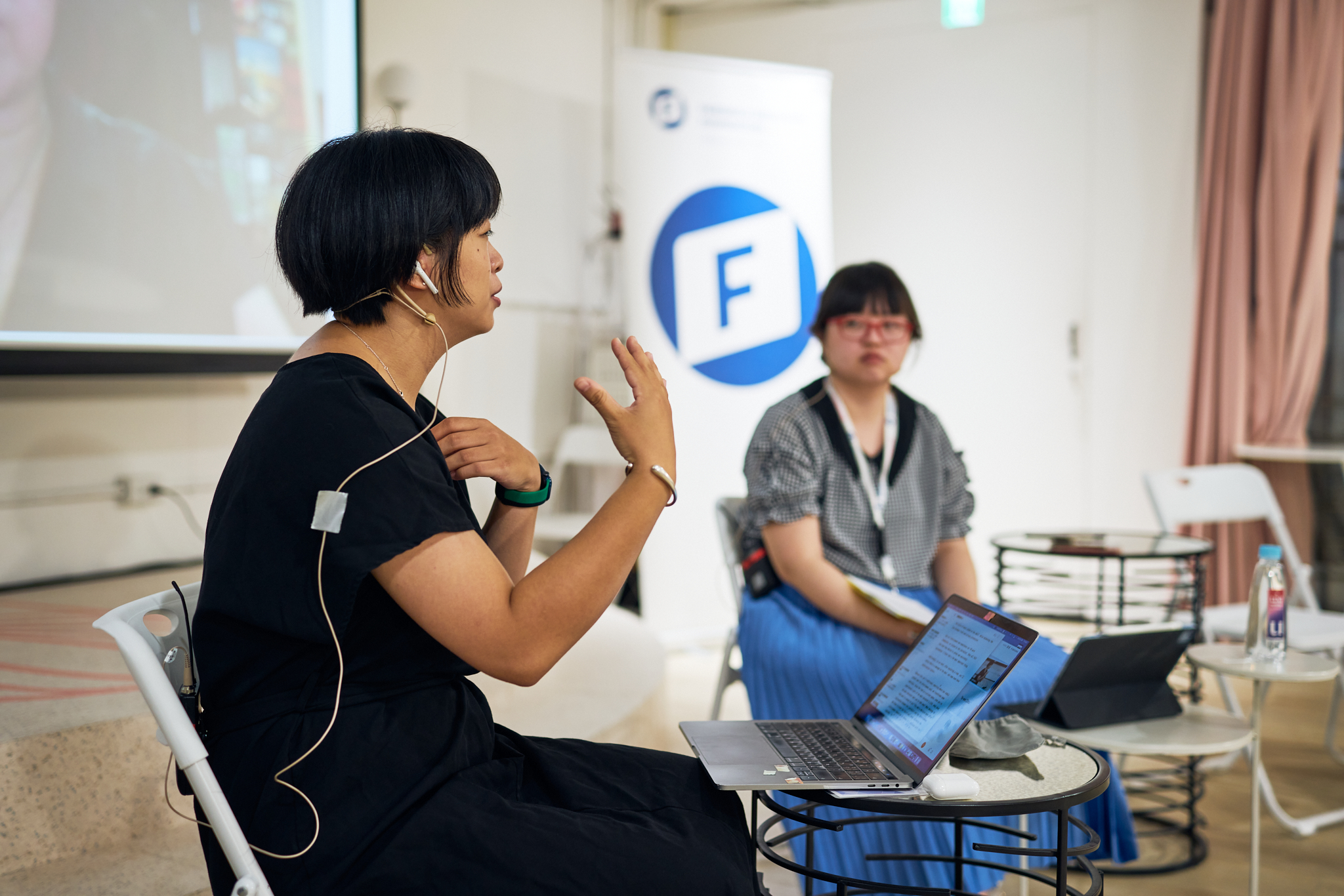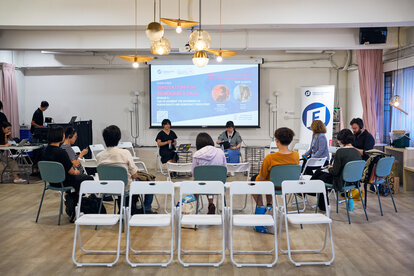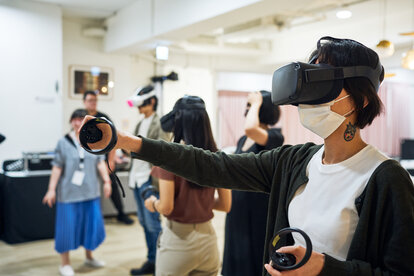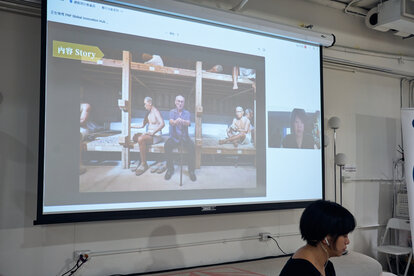Event
The 5th I4D Café: What Role Does VR Technology Play in Fostering Democracy Education?

Ms. Zoe Lee presented her project at FNF's Innovation for Democracy Cafe.
© Ben SahlmüllerVirtual reality (VR) isn’t solely for entertainment. It’s a powerful tool to preserve and convey important messages and historic facts that should never be forgotten, transcending both time and physical boundaries.
In the 5th episode of Innovation for Democracy Café, Ms. Zoe Lee, a journalist from READr and producer of the VR project The Rooms: Stories from Hongkonger in Exile, and Ms. Singing Chen, a movie director specializing in fiction, documentaries and VR films and the director of the award-winning VR film “The Man Who Couldn’t Leave,” demonstrated how to blend VR technology with human rights and democracy education.
Leveraging the immersive capabilities of VR, these experts led the audience to delve into the memories of individuals who have experienced pivotal events related to democracy and human rights. This enables the audience to establish deeper emotional connection with these important democracy and human rights incidents, rather than merely learning those through the texts in books.
Step into the Lives of Hongkongers in Exile through VR
The bedrooms are intimate spaces filled with memories, emotions, scars, and solitude. For those Hongkongers who sought refuge in Taiwan after the enforcement of Hong Kong National Security Law, their bedrooms became sanctuaries, the only places providing safety and security.
That was what Ms. Lee and her team learned after interviewing some HongKongers in Taipei. Bearing that in mind, Ms. Lee and her team recreated the bedrooms through VR based on these interviews. Within these rooms, audiences get to interact with the objects, read notes on the walls, watch videos portraying their dreams and traumas, and listen to the room owners telling their stories.
In these rooms, audiences stepped into the shoes of the Hongkongers, gaining a unique perspective on their experiences instead of just reading texts on news reports.
Using VR to Enhance People’s Understanding of Taiwan’s White Terror Period
As Ms. Singing Chen strolled through Taiwan’s Green Island White Terror Memorial Park's wax museum, she felt time coalesced and enveloped her, inspiring the idea of incorporating voices into the wax figures. This concept led to the creation of a more immersive film in which voices and movements breathe life into the historical narratives, ultimately giving birth to the movie The Man Who Couldn’t Leave.
Sharing insights into the film’s concept and setting, Ms. Chen revealed that through VR goggles, audiences would be immersed in a first-person perspective, seamlessly transported back to the 1950s, enabling them to relive the past as active participants of the victims’ lives during the White Terror authoritarian governance period in Taiwan.
In this way, VR helps to establish audience’s personalized experience of the history, and such experience elicits their empathy to what the victims went through, suffered and hoped, encouraging them to recognize the significance of this historical event.
Ms. Chen hopes that with the help of VR, more citizens can establish their own connection with these important history incidents regarding democracy and human rights instead of considering those as having nothing to do with themselves.

Participants listened to the presnetations of Ms. Zoe Lee and Ms. Sining Chen.
© Ben SahlmüllerWhat Did VR Innovate: Transforming Passive Viewing into Active Experiences
Both speakers emphasized that VR significantly augments the scope and degree of audience experiences. In addition, VR empowers viewers to play active roles in a movie, enabling them to construct their subjective understanding of the story.
Ms. Lee explained that the feature of VR allowed her team to translate abstract concepts, such as the dreams and emotions of HongKongers in exile, into tangible experiences for the audience.
For example, within the VR environment, the audience can hear the sound of police car siren or a doorbell on the scene, connecting them to the fears and anxieties of the room owners.
Ms. Chen emphasized that VR provides unique body sensation that other media cannot achieve, immersing the audience in the emotions and experiences of characters as well as the story’s environment.
Ms. Lee said, “Humans are bound by our bodies, our society’s rules, the space...there are so many boundaries, but VR allows us to become something in the virtual world, so this ‘being something’ is the crucial experience, and in my opinion, that’s the magic of VR.”
She also summarized Mr. Jaron Lanier’s idea in his book Dawn of the New Everything: a journey through virtual reality: comparing to most of the technologies which make you feel that reality is a math of electronic things or allows you act with them as if they were human beings, VR can bring you subjunctive experience that proves you are a real human.
Ms. Singing Chen pointed out that in the realm of VR, the entire 360 degrees of space can be utilized by the audience, fundamentally changing the audience's information absorption compared to traditional cinema.
The audience have the freedom to turn their bodies around, look up and down, and observe the whole space. This unique characteristic of VR films not only alters how stories unfold, but also allows the audience to take control of the sequence of their visual exploration and can almost edit their own version of stories by just turning around their VR goggle.

On-site participants experiencing “The Rooms: Stories from Hongkonger in Exile”
© Ben SahlmüllerHow to Make VR A Helping Force: Tips and Reminders
Since VR allows the audience to subjectively choose what they want to see and experience in the movie, Ms. Chen highlighted that those aiming to produce a VR film should think from the audience’s perspective when crafting narrative, designing the sounds, spaces, and images. This way, the audience can also feel more connected and involved in the experience.
Ms. Chen stated that this approach fundamentally differs from the conventional “languages of movies” in film-making, where creators don’t necessarily need to consider the audience’s perspective. However, single perspectives hinder the audiences’ comprehension of a VR story, requiring the creators of VR projects to pay extra attention to the intricate connection between human sensory perception, VR, and media forms for a more nuanced and effective storytelling.
Moreover, Ms. Chen elaborated that VR allows audiences to have a 360-degree view, so creators of a VR movie have to think about how to delicately arrange what they want the audience to see in 360-degree space, carefully frame every scene, and smoothly connect different scenes in such a space with multiple sides.
On the other hand, Ms. Chen also shared that as emotions and experiences of individuals are abstract and depicting history involves understanding tremendous context, figures, and key incidents, it may be challenging to explicitly illustrate them through VR.
For example, Ms. Singing Chen mentioned that all the narratives she and her team received and collected from the victims of the White Terror were compelling and worth sharing, leading to the difficulty of selecting excerpts for the film. Their solution was to create a fictional story combining stories of different individuals.
Ms. Lee reminded that accessibility can pose a serious obstacle because VR equipments are not as ubiquitous as cellphones or other essential electronic devices.
To address this, they created a website as an alternative platform, ensuring that the narratives inside their VR rooms could reach a broader audience. It serves as a reminder that when using VR, it’s crucial to assess the degree of accessibility in local context and be ready to tackle inaccessibility.
Experimenting New Technology Should Be Encouraged
Both panelists’ experiences show that their decision of trying to apply VR does successfully augment the audiences’ experience that traditional media cannot offer and innovate the approach of telling a story whose topics are about human rights and democracy.
Ms. Lee stressed that this technology definitely has more potential beyond gaming and entertainment. Moreover, as she was involved the entire process of this project, from brainstorming to execution, she gained a clearer understanding of what the media can and cannot do. Therefore, she encouraged the participants to not be afraid of trying out new things even in the face of doubt.
Click here to watch the event video

Ms. Singing Chen shared her experience of making The Man Who Couldn't Leave.
© Ben Sahlmüller. The copyright of the picture of The Man Who Couldn’t Leave belongs to The Walkers Film Production.